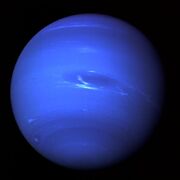| Planet | |
|---|---|
 | |
|
Object type |
Celestial Body |
|
First discovery of object |
N/A |
A Planet is defined as any celestial body consisting of solid matter, and can also consist of liquids and gases that is smaller than a star, but larger than an asteroid. Hundreds of planets are known to science, most notably the eight that orbit Sol (our Sun). Of the eight in the Solar System six have natural satellites orbiting them.
Varities of Planets[]
There are several varities of planets known to science, they include terrestrial planets (e.g. Earth, Venus) which are predominantly liquid magma and thick rock crusts, gas giants (e.g. Saturn, Neptune) which consist of a small rock core and large quantities of gas and liquid surrounding it. Slightly smaller than true planets are dwarf planets (e.g. Pluto, Eris), planetary bodies with similar internal structures but considerably smaller.

Neptune, a typical Gas Giant

Venus, a typical Terrestrial planet
Examples of Planetary bodies of the Sol System[]
| Terrestrial Planets | Gas Giants | Dwarf Planets |
| Mercury | Jupiter | Ceres |
| Venus | Saturn | Pluto |
| Earth | Uranus | Eris |
| Mars | Neptune | Orcus |
| Sedna | ||
| Haumea | ||
| Quaoar | ||
| Makemake |
Extra-solar planets[]
The search for extra solar planets officially began in the 1980's with the first confirmation of extra-solar planets occurring in 1992 when several planetary bodies were discovered orbiting a pulsar designated as PSR B1257+12. At the conclusion of 2011 716 extra-solar planets were known to science, some thousands of light-years away.
The Search for Extra-Terrestrial Intelligence (SETI) organisation has identified several habitable planets in their suns ecospheres that could harbour life similar to that on Earth, possibly intelligent (e.g. Gliese 581 IV).

Artists impression of an extra-solar planet